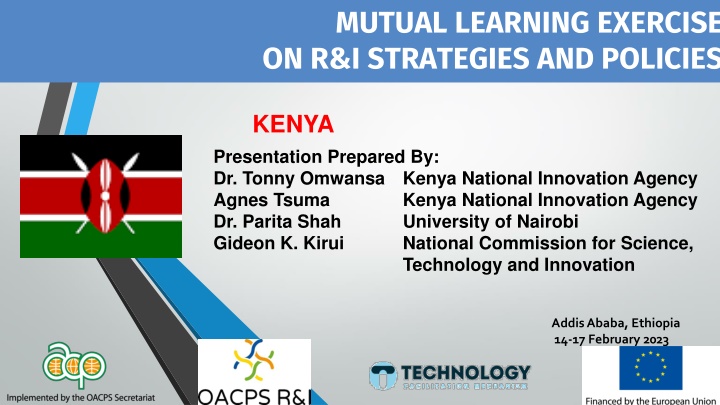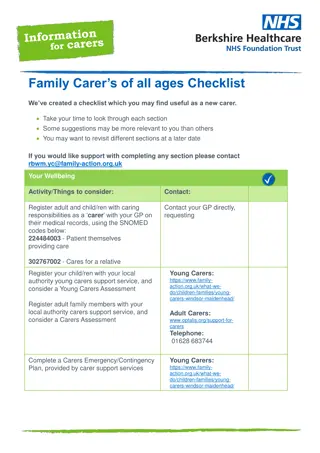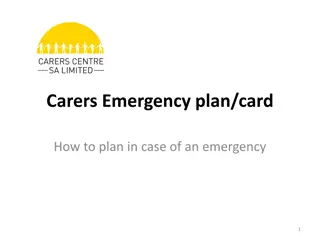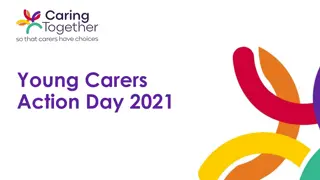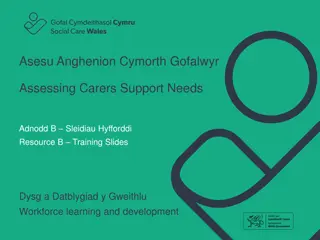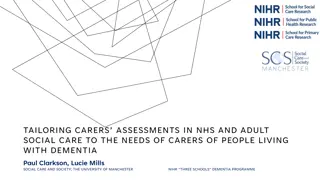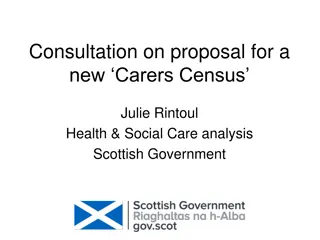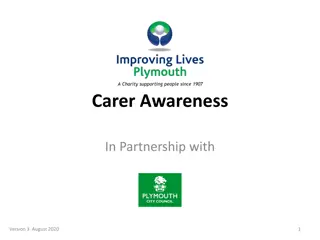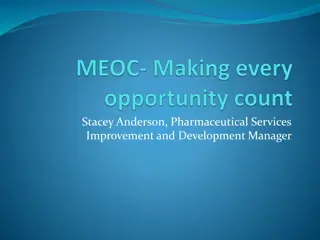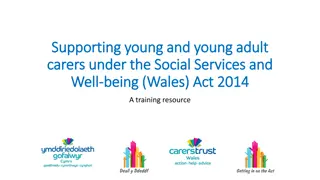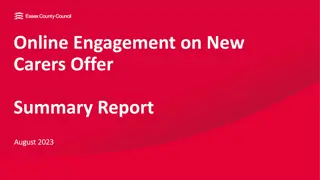Carers Focus Group Research Insights
Gain insight from carers, carers organisations, and professionals supporting carers to develop a new strategy in early 2022. Thematic analysis of focus groups held from October to December 2021 provides key findings on the importance of peer support, carers' identity, and involvement in decision-making.
Download Presentation

Please find below an Image/Link to download the presentation.
The content on the website is provided AS IS for your information and personal use only. It may not be sold, licensed, or shared on other websites without obtaining consent from the author.If you encounter any issues during the download, it is possible that the publisher has removed the file from their server.
You are allowed to download the files provided on this website for personal or commercial use, subject to the condition that they are used lawfully. All files are the property of their respective owners.
The content on the website is provided AS IS for your information and personal use only. It may not be sold, licensed, or shared on other websites without obtaining consent from the author.
E N D
Presentation Transcript
MUTUAL LEARNING EXERCISE ON R&I STRATEGIES AND POLICIES KENYA Presentation Prepared By: Dr. Tonny Omwansa Kenya National Innovation Agency Agnes Tsuma Kenya National Innovation Agency Dr. Parita Shah University of Nairobi Gideon K. Kirui National Commission for Science, Technology and Innovation Addis Ababa, Ethiopia 14-17 February 2023
Objective: To provide context and an overview of R&I Ecosystem Key R&I and/or STI background and contextual factors relevant to this MLE 1977, Science and Technology (S&T) Act (Cap 250) enacted. Act established National Council for Science and Technology (NCST)-mandate national S&T priorities and advice Government on national S&T Policy. Background and country context - Kenya
Science, Technology and Innovation Act, 2013 repealed Science and Technology Act (CAP 250) of 1977 STI Act, 2013 established National Commission for S,T,I (NACOSTI), Kenya National Innovation Agency (KENIA) and National Research Fund (NRF). Act provides framework for coordinated approach- facilitate promotion and regulation of progress of STI with coordination under Ministry of Higher Education& Research.
What is the status of your R&I and/or STI policy? development of STI Policy currently going on How effective is the monitoring and evaluation of the STI policy? STI Policy under development to incorporate M and E framework Optional questions: What are the main development challenges in your country? Food Security, Healthcare, Manufacturing, Housing How do development challenges align with priority areas for R&I and/STI policy interventions in your country? STI provides avenues for addressing challenges e.g. use of STI for transformative agricultural practices, leveraging on tech for health care provision, innovation in manufacturing and use of tech in low cost housing development
Objective: To understand the main R&I ecosystem actors and stakeholders in your country Government, Ministries and Public Agencies National Gov, County Gov, Parliament, Ministry of Higher Education & Research (and other Gov Ministries), NACOSTI, NRF, KENIA, Other Gov Agencies (KIPI, KEBS, NEMA e.t.c) Industry, Private Sector, Firms Manufacturing firms, Service providers, Medium Small Medium & Micro Enterprises, Start-up firms, Financing Institutions, Venture Capitalists Main R&I / STI ecosystem actors and stakeholders in your country Understanding the R&I (and STI) Ecosystem Civil Society Organizations, NGOs, Regional, African and International Organizations Business incubation centres, media, Kenya National Academy of Sciences (KNAS), East Africa Science and Technology Council (EASTECO), Africa Academy of Sciences Research, Knowledge and Skills Producers Universities, Research Institutions, Technical and Vocational Training Institutions, Basic Education Institutions, Researchers. Partnerships between public and private stakeholders like Safaricom and the Government
R&I Ecosystem Analysis - I Objective: SWOT Analysis for STI STRENGTHS WEAKNESSES Existence of legal and regulatory framework Institutional STI drivers in place: NACOSTI, NRF KENIA Existing collaborations, partnerships with regional and international organizations Inadequate decentralization of STI activities Inadequate financing to STI Weak knowledge management framework National appreciation of role of STI in National development Inadequate management of IP rights
OPPORTUNITIES THREATS Devolved system of Gov Weak coordination frameworks Partnerships with regional and international organizations Inadequate funding Roll out of Competency Based Curriculum (CBC) Cyber Security Threats Youthful population Pandemics & Climate Change New and emerging tech
Optional questions: What mechanisms are being deployed to address the weaknesses and threats identified in the R&I ecosystem? Partnership with county governments to establish county STI offices to enhance decentralization and improve coordination Resource mobilization through collaborations and partnerships in STI financing and continued awareness creation on role of STI in National Development Capacity building on knowledge management and IP Rights management Capacity building on cyber security
Could improvements in R&I and/or STI policies help in addressing weaknesses and threats? Yes, by establishing a formal mechanism of addressing challenges and setting out the role of each player What are the opportunities for R&I policy to foster transformation? The policy will incorporate measurable deliverables which will provide opportunity to gauge progress over time
R&I Ecosystem Analysis - II Objective: To help identify and assess framework conditions that foster or hinder transformative change through R&I policy (PESTLE analysis) Category Issue Impact on STI Political National Development Agenda Political leaders recognition and support of STI sector as key driver of socioeconomic development Align institutional program to national development agenda Development long-term plans for the STI sector Political stability Devolution Framework to utilize County Governments structures to promote STI Economic Resource constraints Limited Resources for STI development High cost of research activities and infrastructure Social Youthful Population Higher levels of awareness on STI Low uptake and utilisation of STI outputs Marginalized groups and demographic dividend Reduced levels of research activities Low productivity and inefficiencies Under-representation in matters of STI
Category Technological Rapid Issue Impact on STI Rapid change in the ICT systems that may require retraining and adaptability Efficiency in STI service delivery, reliable and accurate data for decision making. Institutionalization of Knowledge Management Technological advancements Knowledge management Cyber security Leakage, loss of data and System failure EnvironmentalClimate change promote multi-disciplinary research. e-Waste Management Blue Economy Legal Constitution ST&I Act 2013 Provides for institutional mandate Implementatio n of Data Protection Act Opportunity for the deployment of green technologies to Cost of compliance for industry players
Objective: To help establish links to the broader/global context of the SDGs - Transformations and development impacts Kenya seeks to achieve through R&I and STI (policy) And in what (priority) areas / SDGs Kenya Vision 2030, aims at transforming Kenya into a newly industrializing, globally competitive middle-income country, providing a high-quality of life to all its citizens Transformation and Development Impacts 3 Pillars: Economic, Social and Political anchored on foundations and enablers for national transformation which include: infrastructure, ICT, STI, Land reforms, public sector reforms, labour and employment, national values an ethics, ending drought emergencies (EDE), security, peace building and conflict resoultions Focus areas in the recent past:Food Security, Healthcare, Manufacturing, Housing
Conclusion insights for MLE Objective: To help summarise the key messages and insights from your country presentation What are the three (3) main recommendations/lessons on R&I policy from your country that can inform mutual / policy learning? An STI Policy will contribute to harnessing the contribution of STI towards the realization of a Country s long-term development goals The process of policy development should involve wide consultations with all stakeholders Policy implementation will require additional investment in STI, better coordination of actors and increased awareness creation
Optional question: What are the 3 best practices on R&I policy from your country that you can share? Having in place an enabling legislation anchoring STI in a legal framework Developing a mechanism for dissemination STI outputs and commercialization of innovations Tapping on local, regional and international partnerships
References https://www.nacosti.go.ke/nacosti/Docs/Information%20Centr e/Science-Technology-and-Innovation-Act-No.-28-of- 20131.pdf https://vision2030.go.ke/publication/kenya-vision-2030- popular-version/
